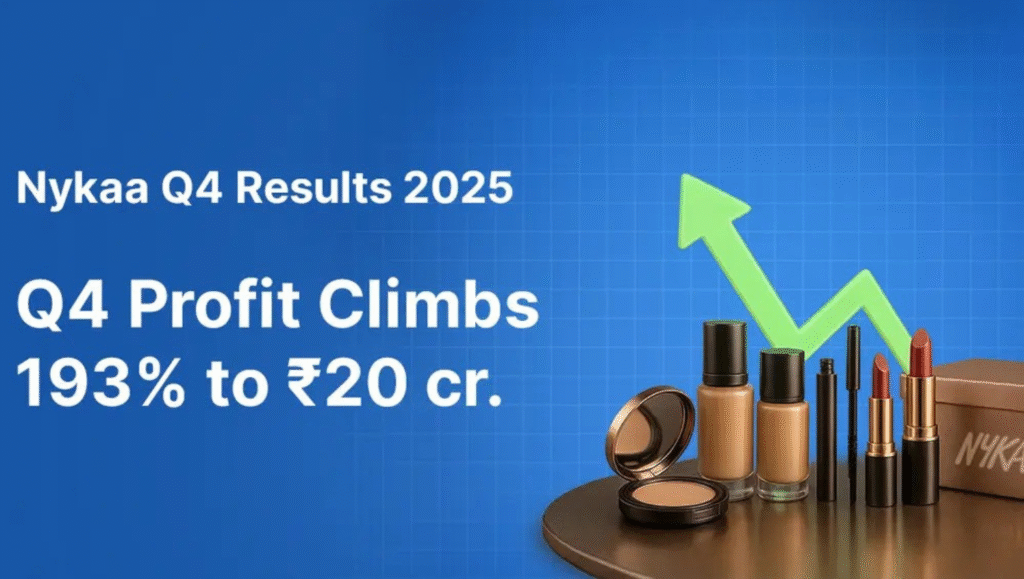
Parent entity FSN E-Commerce Ventures that owns Nykaa has reported a fabulous Q4 FY25, with consolidated net profit jumping a whopping 192.64% YoY to ₹20.28 crore from ₹6.93 crore in Q4 FY24, as per a May 30, 2025, LiveMint report.
Notwithstanding a 22.36% quarter-on-quarter profit decline from ₹26.12 crore in Q3 FY25, Nykaa’s operating revenue grew 23.61% YoY to ₹2,061.76 crore, led by strong growth in its BPC business and growth in fashion and B2B distribution. For India’s USD 3.5 trillion economy, Nykaa’s success highlights the e-commerce boom, but MSME integration and digital literacy deficits may test scaling a USD 50 billion beauty market by 2030.
Nykaa’s BPC segment set the pace, posting a 30.8% YoY gross merchandise value (GMV) growth to ₹11,775 crore in FY25, ahead of industry growth, according to a 2025 BusinessToday report. The firm’s omnichannel strategy stood out with its offline presence growing to 237 stores in 79 cities, achieving 31% YoY GMV and 15% same-store sales growth, as per a 2025 News18 report. Its B2B beauty distribution business Superstore by Nykaa achieved 57% YoY GMV growth to ₹941 crore, catering to over 2.76 lakh retailers in 1,100 cities, as per a 2025 LiveMint report. EBITDA increased 43% YoY to ₹133 crore, with margins expanding 90 basis points to 6.5%, which indicates operational efficiency, according to a 2025 BusinessToday report.
The shares of Nykaa dropped almost 5% on June 2, 2025, despite the robust performance, amid worries over soft fashion segment performance and increased tax effects, according to X posts. Revenue fell 9% quarter-on-quarter (QoQ) from ₹2,267.21 crore in Q3 FY25, driven partly by seasonal content activity, which occurs in the peak period of Q3, according to a 2025 LiveMint report.
The analysts are cautiously optimistic, with Nuvama and Jefferies continuing their ‘buy’ ratings with target prices of ₹235 and ₹240, respectively, as fashion and B2B segment losses declined, according to a 2025 LiveMint report. Nykaa’s total customer base expanded 28% to 42 million, driven by fast delivery service Nykaa Now, according to posts on X.
India’s e-commerce industry, which is growing at a 21% CAGR to reach USD 300 billion by 2030, according to a 2024 FICCI report, is aided by programs such as PM Gati Shakti, reducing logistics expenses by 20%, and the Open Network for Digital Commerce (ONDC), increasing MSME access by 25%, according to a 2024 SIDBI report.
The ₹50,000 crore PLI scheme benefits MSMEs, which provide 30% of inputs to beauty products, according to a 2024 CII report. Skill India’s 2 million skilled employees, while only 5% skilled in e-commerce technology, support digital adoption, according to a 2024 Nasscom report.
There are still challenges. MSMEs incur compliance expenses of ₹1–2 lakh a month, capping scalability, according to a 2024 SIDBI report. Tier 2 cities’ digital literacy deficiencies, where only 15% of the retailers are digitally literate, curb adoption of ONDC, with only 15% of MSMEs registered, as per a 2024 Nasscom report. Deficiencies in infrastructure, such as irregular power supply, interrupt online transactions for 20% of rural merchants. Delays in e-commerce approvals, requiring 4–6 years compared to China’s 2, impede innovation, according to a 2024 CII report. Volatility in global supply chains, hitting 30% of cosmetic imports, puts pressure on it, according to a 2024 UNCTAD report.
Solutions are suggested by experts. The Technology Upgradation Scheme subsidies can relax MSME expenses. Scaling up Skill India’s e-commerce skills can fill gaps. PM Gati Shakti can enhance 5G and power reliability, stabilizing platforms. Public-private partnerships with IITs can create affordable technology solutions. CII-led campaigns can accelerate ONDC adoption and digital literacy.
Nykaa’s Q4 FY25 performance, with a close to three-fold rise in profit, solidifies leadership in India’s beauty and e-commerce sector. Nykaa and India can leverage this growth momentum through overcoming MSME, literacy, and infrastructure challenges, aligning with a Viksit Bharat by 2030.
